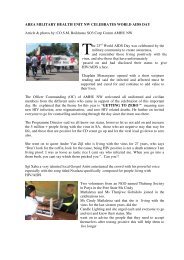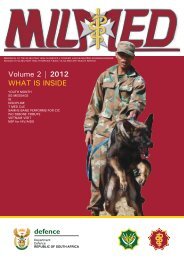MilMed Jan Feb 2007.qxp - SA Military Health Service
MilMed Jan Feb 2007.qxp - SA Military Health Service
MilMed Jan Feb 2007.qxp - SA Military Health Service
Create successful ePaper yourself
Turn your PDF publications into a flip-book with our unique Google optimized e-Paper software.
Written and photographed by Lt John Sverdloff <strong>SA</strong>AF photographs by WO2 Christo Crous (5 ASU)16Aviation Medicine started as the central medicalestablishment in Voortrekkerhoogte (then RobertsHights) during 1941, and later was renamed the<strong>Military</strong> Medical Institute. In 1970 it once againchanged its name , this time to the Institute of AviationMedicine (IAM), and relocated in Lyttleton, Pretoria.Aspirant <strong>SA</strong> Air Force (<strong>SA</strong>AF) pilots go to the Institute forAviation Medicine for a physical examination, whichincludes the checking of ears, nose, throat, eyes, urine andblood. A stress ECG, lung function test and EEG are alsodone. All this is included in a routine medical examination,except for an EEG. Body measurements, psychologicaltesting and altitude testing is conducted as part of <strong>SA</strong>AFpilot selection.The IAM assist those who do not meet the set medicalstandards, eg high blood pressure can be treated withappropriate medication.More complicated cases are seen on a day-to-day basis.This includes referrals from the private and military sector,medical standards and technical issues, as well as the dayto-daytreatment of pilots who fly with diseases or who usemedication.The Institute also sets up and develops aviation standardsfor <strong>SA</strong>AF and civilian pilots. A new aspect that is in thepipeline is the physiological training and research of pilots,which will include gravitation, disorientation, hypoxia andmany other aspects of training, as well as breathingapparatuses with specialised equipment, eg Halo (SpecialForces).Aviation medical research will also be done in order to findways to protect pilots in the environments they are flying in.All registered aviation medical doctors from across thecountry send aviation medical examinations to the Institutefor certification. The entire aviation medical examination ischecked for compliance and adherence to standards beforeit is confirmed.The Institute also develops aviation medical standards. TheIAM takes foreign and <strong>SA</strong>AF standards compares them toour population groups. The lung function of the averageAfrican, for instance, differs from that of the averageEuropean. Foreign aircraft cockpits can also differ from oursin terms of size.The <strong>SA</strong>NDF has aviation doctors at various <strong>SA</strong>AF bases, egYsterplaat, Langebaanweg and Bloemspruit. The aviationmedical examiners at these bases are able to conducttheir own examinations, but results must be certified at







